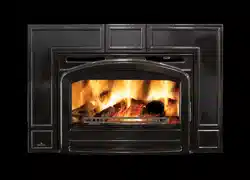Loading ...
Loading ...
Loading ...

EN
W415-2007 / D / 04.28.21
7
general information
This appliance was specifically designed to meet the U.S. EPA 2020 particulate emission standards and has been
extensively tested in Canadian laboratories to be efficient, simple, and trouble free.
The appliance uses clean-burning technology found in all Napoleon EPA certified stoves equipped with a heat circulating
blower. External modifications have been made to allow its installation as a “functional insert” with a heat circulating blower
system, as well as a means of enclosing the solid fuel burning fireplace cavity for greater heating efficiency.
The appliance must only be installed into a solid fuel burning fireplace that is at least 18” (45.7cm) deep, 27” (68.6cm)
wide, and 22” (55.9cm) high with an approved lined chimney at least 15’ (4.6m) high and a hearth at least 18” (45.7cm)
wide for Canada and 16” (40.6cm) wide for USA. This minimum recess can only be achieved if the opening height is
sufficient enough to allow the connector to fit under the non-combustible facing. The appliance and chimney must be
constructed in accordance with all national and local building code standards.
The chimney vent system used on this wood burning appliance should be designed with the least amount of restriction
possible to enable the flow of exhaust products. Chimney vent systems that are too short or too long can also have an
adverse affect on the flow of exhaust.
The wood burning appliance and chimney vent system require
a sufficient supply of combustion air, not only to support the
combustion in the combustion chamber, but to replace the
outbound exhaust.
Secondary air from the side intake openings travels up to
the secondary air housing, and then to the manifold located
across the top. Finally, it flows out laterally to oxidize the gases
below the smoke exit.
The combustion chamber is lined with high temperature
refractory firebricks on the sides, back, and bottom. A
fibre baffle on top helps maintain a high temperature in the
combustion chamber so that gases mixing with the preheated
air from the secondary air manifold tubes are easily ignited and
burned.
There are many other appliances in the home competing
with the appliance for air, such as kitchen range hoods,
forced air heating devices, and bathroom exhaust fans.
Therefore, in order to avoid fire hazards and/or injuries, be
sure to provide sufficient combustion air to the appliance.
Expansion / contraction noises during heating up and
cooling down cycles are normal and to be expected.
After extended periods of non-operation (i.e. vacation, warm
weather season, etc.), the appliance may emit a slight odour for a few hours as a result of dust particles in the
firebox burning off. If this happens, open a window to sufficiently ventilate the room.
Model EPI3-1 meets the 2020 U.S. Environmental Protection Agency (E.P.A.) particulate emission standards using
cordwood, 40 CFR Part 60, Subpart AAA. This appliance has been tested by Services PolyTests Inc. and listed by
CSA Group to standards: ULC-S628, UL1482.
If the appliance begins smoking, open a door or window, or
supply the appliance with combustion air in some other way.
1.4 general information
AIR INLET PATH
EXHAUST PATH
We suggest that our woodburning hearth products
be installed and serviced by professionals who are
certified in the U.S. by the National Fireplace
Institute® (NFI) as NFI Woodburning Specialists or
who are certified in Canada by
Wood Energy Technical
Training (WETT).
Loading ...
Loading ...
Loading ...
